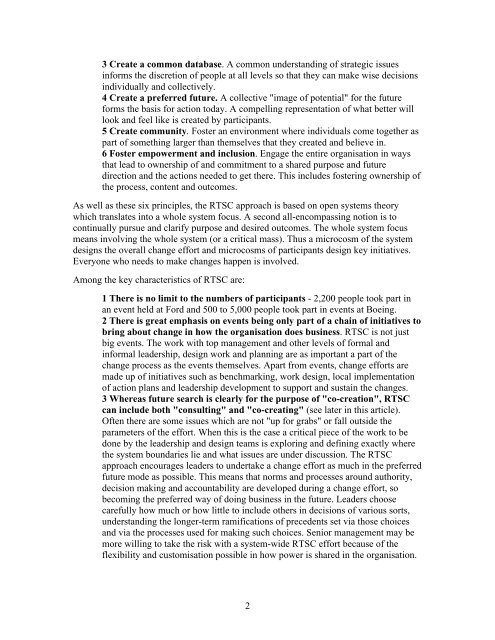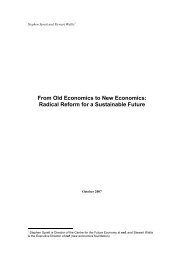Creating the futures we desire - getting the whole ... - Bruce Nixon
Creating the futures we desire - getting the whole ... - Bruce Nixon
Creating the futures we desire - getting the whole ... - Bruce Nixon
You also want an ePaper? Increase the reach of your titles
YUMPU automatically turns print PDFs into web optimized ePapers that Google loves.
3 Create a common database. A common understanding of strategic issues<br />
informs <strong>the</strong> discretion of people at all levels so that <strong>the</strong>y can make wise decisions<br />
individually and collectively.<br />
4 Create a preferred future. A collective "image of potential" for <strong>the</strong> future<br />
forms <strong>the</strong> basis for action today. A compelling representation of what better will<br />
look and feel like is created by participants.<br />
5 Create community. Foster an environment where individuals come toge<strong>the</strong>r as<br />
part of something larger than <strong>the</strong>mselves that <strong>the</strong>y created and believe in.<br />
6 Foster empo<strong>we</strong>rment and inclusion. Engage <strong>the</strong> entire organisation in ways<br />
that lead to ownership of and commitment to a shared purpose and future<br />
direction and <strong>the</strong> actions needed to get <strong>the</strong>re. This includes fostering ownership of<br />
<strong>the</strong> process, content and outcomes.<br />
As <strong>we</strong>ll as <strong>the</strong>se six principles, <strong>the</strong> RTSC approach is based on open systems <strong>the</strong>ory<br />
which translates into a <strong>whole</strong> system focus. A second all-encompassing notion is to<br />
continually pursue and clarify purpose and <strong>desire</strong>d outcomes. The <strong>whole</strong> system focus<br />
means involving <strong>the</strong> <strong>whole</strong> system (or a critical mass). Thus a microcosm of <strong>the</strong> system<br />
designs <strong>the</strong> overall change effort and microcosms of participants design key initiatives.<br />
Everyone who needs to make changes happen is involved.<br />
Among <strong>the</strong> key characteristics of RTSC are:<br />
1 There is no limit to <strong>the</strong> numbers of participants - 2,200 people took part in<br />
an event held at Ford and 500 to 5,000 people took part in events at Boeing.<br />
2 There is great emphasis on events being only part of a chain of initiatives to<br />
bring about change in how <strong>the</strong> organisation does business. RTSC is not just<br />
big events. The work with top management and o<strong>the</strong>r levels of formal and<br />
informal leadership, design work and planning are as important a part of <strong>the</strong><br />
change process as <strong>the</strong> events <strong>the</strong>mselves. Apart from events, change efforts are<br />
made up of initiatives such as benchmarking, work design, local implementation<br />
of action plans and leadership development to support and sustain <strong>the</strong> changes.<br />
3 Whereas future search is clearly for <strong>the</strong> purpose of "co-creation", RTSC<br />
can include both "consulting" and "co-creating" (see later in this article).<br />
Often <strong>the</strong>re are some issues which are not "up for grabs" or fall outside <strong>the</strong><br />
parameters of <strong>the</strong> effort. When this is <strong>the</strong> case a critical piece of <strong>the</strong> work to be<br />
done by <strong>the</strong> leadership and design teams is exploring and defining exactly where<br />
<strong>the</strong> system boundaries lie and what issues are under discussion. The RTSC<br />
approach encourages leaders to undertake a change effort as much in <strong>the</strong> preferred<br />
future mode as possible. This means that norms and processes around authority,<br />
decision making and accountability are developed during a change effort, so<br />
becoming <strong>the</strong> preferred way of doing business in <strong>the</strong> future. Leaders choose<br />
carefully how much or how little to include o<strong>the</strong>rs in decisions of various sorts,<br />
understanding <strong>the</strong> longer-term ramifications of precedents set via those choices<br />
and via <strong>the</strong> processes used for making such choices. Senior management may be<br />
more willing to take <strong>the</strong> risk with a system-wide RTSC effort because of <strong>the</strong><br />
flexibility and customisation possible in how po<strong>we</strong>r is shared in <strong>the</strong> organisation.<br />
2



